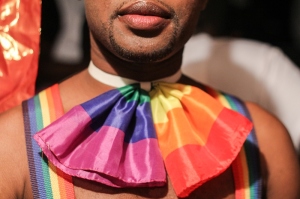“NOCTAMBULES: the hidden transcripts”
photographs by Josué Azor
curated by David Frohnapfel
Vernissage
19h30, 6th April, 2015
Villa Kalewes, 99 Rue Gregoire, Petionvile, Port-au-Prince
Conference & Artist Talk “La deconstruction du genre”
Barbara Prezeau-Stephenson, Josué Azor, Maksaens Denis and David Frohnapfel in conversation
16h30-18h30, 7th April, 2015
FOKAL, 143 Avenue Christophe, Port-au-Prince
Haiti’s gay, lesbian, bisexual and transgender communities have long kept a low profile because of a strong social stigma that sparks fear of physical violence or social isolation. The Caribbean in general was often labeled as one of the most homo- und transphobic regions in the world. In April 2015 the forum transculturel d’art contemporain will discuss the theme Creation & Counterpower. As part of this conceptual framework the exhibition project “NOCTAMBULES: the hidde transcripts” will ask which social processes mark the LGBT community in Port-au-Prince as deviant and how homosexuality can manifest itself as a powerful counter-culturein this hostile and heteronormative environment. Which are the hidden transcripts (James Scott) and communal bonds the LGBT community in Port-au-Prince creates to resist marginalization and heal the wounds of permanent sexual oppression? Can art be a mechanism to escape the heteronormative matrix of power by developing particular queer aesthetic sensibilities? Can we find certain aesthetic codes that resist against a hetero-centrist colonialization of the visual arts? Josué Azor’s photographs document how an engagement celebration of two men was violently interrupted by homophobic attacks and juxtaposes these disturbing images of violence with the joyful celebrations of gay youth in Port-au-Prince at night. These juxtapositions of violence and release create awareness of queer infrapolitics and reflect on the socio-political disobedience of men and women in Haiti who search for possibilities to escape social discrimination and oppression by a dominant hetero-patriarchy.
We consider art as a potent means of stirring consciousness and propelling dialogue on queer identities and experiences in Haiti. Although there is a high percentage of “queer” artists working in Port-au-Prince, the subject matter hasn’t been discussed within any exhibition or academic forum. Can we speak of a particular queer sensibility within the Haitian artistic scene? And if so how can we bypass queer ghettoization as well as the danger that lies in generalizations and essentialist discourses. Our main goal is to contribute to destabilize fixed notions of identity in Haiti and to deconstruct clear binaries such as heterosexual/homosexual, gay/lesbian and masculine/feminine, as well as the concept of heteronormativity in general. But isn’t the use of the term “queer” already risking to reinstall boundaries of exclusive politics?
Furthermore, we put the focus on the medium of photography with our exhibition. Photography is one of the most underrepresented artistic media in Port-au-Prince. Most art galleries in Haiti are specialized on the “naive painting” tradition and cultural institutes like Institut Français d’Haiti and Fokal do not have adequate exhibition spaces to showcase photography or contemporary art in general. Therefore, our exhibition will support young photographer Josué Azor and underlines the importance of photography as a vivid, creative and emerging medium in Port-au-Prince. Although the institutional landscape for the presentation of photography in Port-au-Prince is non-existent, that does not preclude that many Haitian photographers like Josué Azor create compelling and inspiring works and fight passionately for international recognition.
The exhibition will be part of the official selection of Fondation AfricAmericA’s biennial project “forum transculturel d’art contemporain”. The forum is a unique opportunity for contemporary artists to showcase their diverse artistic practices in Port-au-Prince for a global audience. It was founded by curator and artist Barbara Prezeau-Stephenson in 2000. The forum’s main goal is to disrupt the isolation of contemporary Haitian art and to create new dialogues between contemporary Haitian artists and a wider international artistic milieu
“NOCTAMBULES: the hidden transcripts”
Photographies de Josué Azor
Commissaire d’exposition David Frohnapfel
Vernissage : 7 :30 pm, 6 avril 2015
Vernissage:
19h30, 6e d’avril 2015
Villa Kalewes, 99 Rue Gregoire, Petionvile, Port-au-Prince
Conférence & Artist Talk “La deconstruction du genre”
Barbara Prezeau-Stephenson, Josué Azor, Maksaens Denis, Mario Benjamin et David Frohnapfel en conversation
16h30-18h30, 7e d’avril 2015
FOKAL, 143 Avenue Christophe, Port-au-Prince
Les communautés gay, lesbien et transgender de Haïti ont pour longtemps adopté un profil bas à cause d’un fort stigma social provocant peur de violence physique ou isolation sociale. En générale les Caraïbes étaient souvent considérés l’une des régions les plus homo- et transphobes du monde. En avril 2015 le forum transculturel d’art contemporain discutera le sujet de Création et Contre-pouvoir. Dans ce cadre conceptuel le projet d’exposition “NOCTAMBULES: the hidde transcripts” s’interroge sur le type de procès sociaux qui identifient la communauté LGBT à Port-au-Prince comme déviante et comment l’homosexualité peut se manifester par un contre-culture puissante au sein de cet environnement hostile et hétéronormatif. Quels sont les hidden transcripts (James Scott) et liens communautaires que la communauté LGBT à Port-au-Prince met en place pour résister la marginalisation et guérir les blessures d’une oppression sexuelle permanente? Est-il possible que l’art puisse devenir un mécanisme pour s’échapper du matrix hétéronormatif du pouvoir en développant de spécifiques sensibilités esthétiques queer? Est-il possible de trouver certains codes esthétiques qui résistent une colonisation hétérocentriste des arts visuels? Les photographes de Josué Azor documentent comment une célébration de fiançailles de deux hommes fut interrompue violemment par des attaques homophobes et juxtaposent ces images troublantes avec les célébrations joyeuses de jeunes gays dans la nuit à Port-au-Prince. Ces juxtapositions de violence et décharge rendent compte d’une infrapolitique queer et réfléchissent sur la désobéissance socio-politique d’hommes et femmes en Haïti qui cherchent des possibilités de s’échapper à la discrimination et oppression sociale d’un hétéro-patriarcat dominant.


